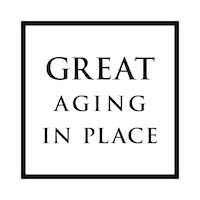Interview/Article by PATRICIA V. RIVERA of CTW FEATURES
As adults stay in their homes longer, they’re making sure they’re prepared for the years ahead.
Like everything else, baby boomers are redefining what it looks like to age in place.
Forget the traditional grab bars for bathroom safety that stick out like a sore thumb. They’re opting for bars that are hidden inside of towel racks, soap holders and toilet paper dispensers. After all, the rest of their home is stylish, too.
“After years of hard work, many have achieved a certain level of comfort and would like to maintain their quality of lifestyle as they get older,” says Lisa Bobulinski Bixler, a Houston architect with a Certified Aging in Place Specialist designation from the National Association of Home Builders.
Nearly 90 percent of adults aged 45 and older surveyed by AARP indicated they wanted to stay in their homes “for as long as possible” as they aged. On the flip side, a study by the Harvard Joint Center for Housing Studies and the AARP Foundation found that “…the bulk of long-term care will occur in single-family owner-occupied homes … but the homes are not prepared.”
A booming aging-in-place industry is starting to offer an array of options, including active adult communities with homes that take into consideration the needs of seniors and offer different levels of care.
“Communities that include independent living allow residents to maintain their independent lifestyle but add a socialization component that is probably missing in their current situation,” notes Kyle Exline, executive director of The Clare, a retirement residence in Chicago.
But when thinking about the home, the key is to consider adaptability, the ability of spaces to be modified for future needs, and “visitability,” the minimum level of accessibility that will allow someone with a disability basic access to the ground floor of a home.
“These are the areas that people are thinking about now so that when a situation does arise, the modifications in their home don’t seem like an afterthought,” notes Bobulinski Bixler.
While it can be challenging to create a “visitable” residence with “curb appeal,” since wider sidewalks and entry elevations make traditional landscaping and hardscaping more difficult, it’s easier to handle when integrating the new needs into the design or remodeling plans of the home, she adds.
To be sure, homes ideal for aging in place include standard features. Debra Cohen owns a referral agency in Nassau County, New York, that prescreens and refers contractors to older homeowners who need to modify or repair their homes. She says a master bedroom and bath on the first floor is the feature most in-demand, followed by a low or zero-threshold entrance to the home and a zero-threshold shower entrance.
Also important are wide doorways to accommodate wheelchairs, non-slip flooring throughout the home and lowered kitchen and bath countertops.
Bobulinski Bixler says the trend now among baby boomers is to prepare homes for aging in place without, necessarily, displaying the hardware. For instance, homes now include interior doors 3 feet wide instead of 2 feet 8 inches, including wall blocking for future fixtures and grab bars.
Retirees also are thinking ahead and building stronger ceiling structures to handle future lifts, and installing conduits for future wiring to allow spaces to be remodeled more easily and affordably when the time comes.
Throughout the house, lever handles are preferred over turn knobs, because of the age-related prevalence of arthritis, Bobulinski Bixler notes.
Some of the features many not even be for the boomers.
These “retirement homes” have to accommodate visiting children, grandchildren, and friends, in addition to the as the needs of their own aging parents. Many are helping care for an elderly or disabled parent who lives with them, Bobulinski Bixler says.
“The advantage is that today people can prepare to age in place without sacrificing an attractive, comfortable living environment,” she says.

